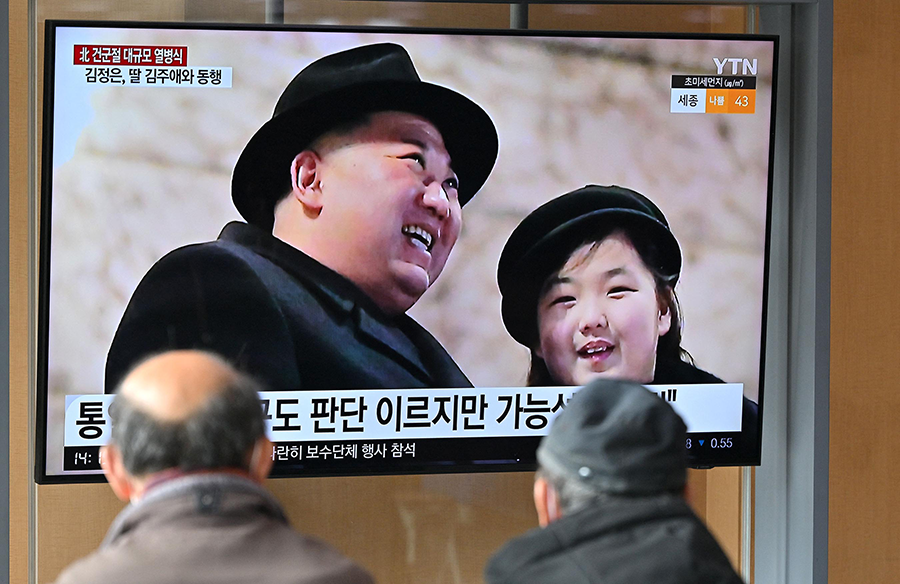North Korea Might Conduct Nuclear Test, U.S. Says
April 2023
By Luke Caggiano
Preparations might be underway for North Korea’s first nuclear test since 2017, U.S. intelligence agencies concluded in their annual threat assessment.
 North Korea “probably is preparing to test a nuclear device to further its stated military modernization goals to facilitate ‘tactical nuclear operations,’” stated the report, which was released March 8 and identifies major U.S. national security threats over the next 12 months. The assessment suggests that North Korea may be moving closer toward conducting its first nuclear test in more than five years, as previous assessments stated that North Korean leader Kim Jong Un “may be considering” a nuclear test.
North Korea “probably is preparing to test a nuclear device to further its stated military modernization goals to facilitate ‘tactical nuclear operations,’” stated the report, which was released March 8 and identifies major U.S. national security threats over the next 12 months. The assessment suggests that North Korea may be moving closer toward conducting its first nuclear test in more than five years, as previous assessments stated that North Korean leader Kim Jong Un “may be considering” a nuclear test.
The 2017 nuclear test was Pyongyang’s largest. (See ACT, October 2017.) Two months later, North Korea tested what it called its “most powerful” intercontinental ballistic missile, the Hwasong-15, which is capable of striking the United States. (See ACT, January/February 2018.)
In March 2023, missile tests, including one involving the Hwasong-17, were conducted in response to U.S.-South Korean military exercises.
The U.S. intelligence community said that Kim remains committed to increasing his country’s nuclear weapons capabilities and that the arsenal serves “as a centerpiece of [Kim’s] national security structure.”
In addition to North Korea, China, Iran, and Russia are expanding their nuclear capabilities and worsening the long-standing threat from weapons of mass destruction, according to the report.
“[G]reat powers, rising regional powers, as well as an evolving array of non-state actors, will vie for dominance in the global order, as well as compete to set the emerging conditions and the rules that will shape that order for decades to come,” it stated.
China is believed to be “reorienting its nuclear posture for strategic rivalry with the United States because its leaders have concluded that their current capabilities are insufficient,” the report said. Beijing has maintained an estimated arsenal of 200–350 warheads over the past several decades, but China’s arsenal now likely exceeds 400 warheads and could grow to 700 by 2027 and 1,000 by 2030. (See ACT, December 2021.)
Bilateral tensions, U.S. nuclear modernization efforts, and China’s advancing conventional capabilities have increased Beijing’s worries of a U.S. nuclear first strike, the intelligence community concluded. Potential arms control with China remains a distant prospect because “Beijing is not interested in agreements that restrict its plans and will not agree to negotiations that lock in U.S. or Russian advantages.”
Meanwhile, Russian President Vladimir Putin has warned multiple times that Moscow stands ready to use nuclear weapons to defend the state. Russia’s full-scale war on Ukraine over the past year has significantly depleted Russian ground and air-based conventional forces, leaving Russia “less capable of posing a conventional military threat to European security.” This major depletion of conventional forces indicates that, as a result, Russia will increasingly rely on its nuclear arsenal.
China and Russia are “seeking to ensure strategic stability with the United States through the growth and development of a range of weapons capabilities, including nontraditional weapons intended to defeat or evade U.S. missile defenses,” assesses the report. For instance, Beijing and Moscow have developed and deployed hypersonic weapons systems with conventional and nuclear capabilities. (See ACT, March 2023.)
In addition, Iran’s accelerated expansion of its nuclear program; its refusal to comply with agreed limits under the 2015 nuclear deal, known as the Joint Comprehensive Plan of Action; and its “research and development activities that would bring it closer to producing the fissile material for completing a nuclear device following a decision to do so” constitute major threats to the United States.
The assessment expands on previous intelligence regarding Iran’s intentions to obtain new conventional systems, including “advanced fighter aircraft, trainer aircraft, helicopters, air defense systems, para-naval patrol ships, and main battle tanks” while it works on “improving the accuracy, lethality, and reliability of its missiles.”
On March 11, Iranian state media announced that Iran had “reached a deal to buy advanced Su-35 fighter planes from Russia,” Reuters reported.
The intelligence assessment also determines that China is working to field a military capability “designed to deter U.S. intervention in a…crisis” involving Taiwan by 2027, while looking to establish potential military bases in Equatorial Guinea, Cambodia, and the United Arab Emirates. The report notes that China has developed a range of ground-based counterspace systems such as “electronic warfare systems, directed energy weapons, and [anti-satellite] missiles intended to disrupt, damage, and destroy target satellites.”
